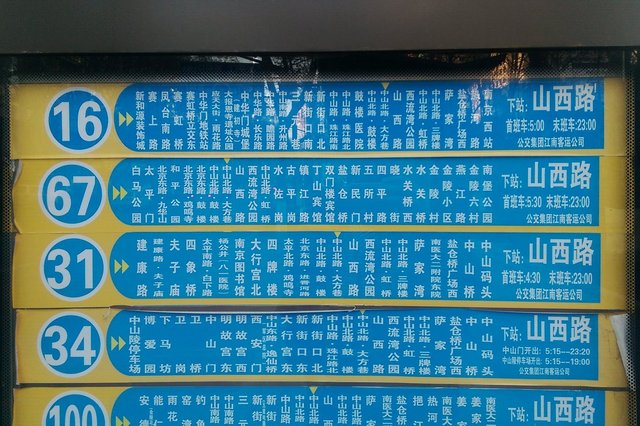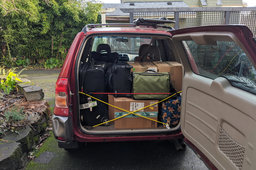Zijin Mountain
Started: 2016-04-03 12:58:12
Submitted: 2016-04-03 15:53:36
Visibility: World-readable
25 January 2016: In which the intrepid narrator visits Sun Yat-sen's mausoleum and other scenic sites on Zijin Mountain, on his last full day in China
On my last full day in Nanjing (which was also my last full day in China) I headed out to see the site that brought me to Nanjing in the first place: Sun Yat-sen's Mausoleum, in the middle of a sprawling park covering the side of Zijin Mountain, a large hill north-east of the city center.
To get there I needed to figure out the city's bus system, which proved somewhat easier said than done. My guidebooks suggested specific routes that I could take (and generally failed to agree which route that should be), but didn't provide any maps or greater framework for understanding how the bus routes worked together. Google Maps' coverage of the bus lines was lacking, probably because Google is officially blocked in China, so the main group of people using Google Maps are tourists and expats with foreign SIM cards or VPNs. I found a number of websites with bus routes in Chinese, and one site with bus routes in English, but none had a map, and I had trouble cross-referencing the locations given on the routes with locations I could find in my maps.
So ultimately I decided to head out and wing it and hope for the best. Which actually proved fairly successful.
I took the metro a few blocks east to a stop where I was supposed to be able to catch a bus to Zijin Mountain. I couldn't find any evidence of the tourist buses, with Y prefixes, that were supposed to be running to Zijin Mountain, possibly because it was the middle of winter and I was the only tourist around. (Today the daily high temperature actually got above freezing, which was a nice change from the past week, though it still wasn't exactly warm.) I found a bus stop that conveniently listed all of the stops for each route serving the stop, but it would have been a bit more useful if it hadn't been entirely in Chinese. I found a route that looked like it terminated at 中山陵, followed by a couple of characters I didn't recognize, which I figured was a good sign, since I knew that 中山, zhong shan, was one of the names given to Sun Yat-sen, and the last character, ling, was tomb or mausoleum.
It turned out that the extra character at the end of the destination meant that the bus stopped at the parking lot, which was still a bit of a walk to the actual mausoleum. The wide path climbed gently up the forested hillside, eventually reaching the main gate of the mausoleum. The whole thing had the air of a site equipped to deal with throngs of tourists, with a large parking lot, and various tourist information centers and cafes and souvenir shops and tea houses scattered about, which were far more than the handful of tourists at the site with me really needed.
I entered the main gate to the mausoleum, built in the style of the imposing tombs the Ming Dynasty built for its emperors. I walked through the gate and down a wooded path leading to a second gatehouse surrounding the mausoleum itself. This was, it turned out, closed because it was a Monday -- which I'd failed to consider as I was planning my schedule. I looked through the fence at the building inside, then turned around to look at the rest of the park.
I caught a shuttle to the next tourist site to the east on Zijin Mountain, the Linggu Temple Scenic Area. This turned out to be a subdued temple complex spread out on the hillside centered around the Beamless Hall, a fourteenth-century temple building that was built out of brick instead of the wood typically used for Ming Dynasty buildings. As a result the center of the temple had a large barrel vault built out of masonry, rather than using large timber beams to support the roof. (It seemed a little silly to make such a big deal out of it, since barrel vaults were well known for millennia before the temple was built, but apparently no one else in the Ming Dynasty did it, so it was special.)
It had snowed a day or two before I arrived in Nanjing, so the ground was dusted with snow in in the shade. I climbed the nine-story Linggu Pagoda, a twentieth-century building constructed out of reinforced concrete. From the top of the tower I could see the skyline of Nanjing in the haze, and the other tourist sites on the mountain.
My guidebooks told me there was supposed to be a vegetarian restaurant at the temple, and I found where it was supposed to be, but it was closed for a reason I couldn't discern. I headed back down to the temple's entrance and caught a tourist shuttle to the third main tourist site on the mountain: the tomb of the first Ming emperor, from the fourteenth century. This tomb, and the tombs of the other Ming emperors around Beijing, make up a UNESCO-recognized world heritage site.
The grounds around the tomb had several buildings and gateways and other structures with various ceremonial functions. The most impressive part of the tomb, though, was the main building itself, an imposing stone building painted red on top of a large base. I climbed up the darkened staircase leading up the middle of the base to gain access to the building on the top, and then walked around to the back to the tomb mound, where the emperor and his empress were actually buried, unexcavated, somewhere in the middle of the mound. I climbed a snow-dusted trail leading up and around the mound, where I could get a view of the wooded hillside, covered in dormant deciduous trees and shrub-sized bamboo.
I left the main area of the Ming tomb, and found myself at the end of the Sacred Path, which was built as the official ceremonial entrance to the tomb. (I had sort of snuck around the back, though that was where the tourist shuttle had taken me.) The Sacred Path was lined with stone figures of animals; it would have been even more impressive in the spring or summer, when the trees had leafed out, but it was fairly impressive even now.
I left the park and tried to figure out how to catch a bus back into the city. I gave up on trying to reading the routes (in Chinese) and decided instead to catch the first bus that came by, on the theory that it probably went somewhere near a metro stop, and I could watch my map on my smartphone and figure out where I should get off to get back to somewhere I recognized. This actually worked -- the bus took me to a part of north-eastern Nanjing I'd never been to before, but the bus stopped right in front of a metro station, where I could actually read the route map, and figure out how to get to where I wanted to go next.
My next destination turned out to be Jiming Temple, a Buddhist temple packed with shrines and statues and idols and incense. It was the middle of the afternoon, and I hadn't yet eaten lunch, so I ate a small noodle bowl at the vegetarian restaurant at the temple, which was enough to keep me going for the rest of the day.
I left the temple and found an access point to climb up the city walls, which divided the city from the adjacent lake. I dropped by a small gallery inside the wall itself with a neat model of the city walls, then walked along the top of the walls until I hit the next gate.
My objective was to find the Yangzee River Bridge, visible from the adjacent park. The bridge was not accessible via the metro, so I had to figure out which bus to take to get to the park. (Or I suppose I could have figured out how to get a taxi to take me there.) My guidebooks gave conflicting information about which bus I ought to take from where. I wandered around the streets where bus #12 was supposed to go (according to at least one of my guidebooks) until I eventually found a stop with bus #12 mentioned on it. By this point it was late afternoon, and the streets and buses were starting to fill up with commuters. I hopped on the crowded bus as it lurched through the crowded streets. I tried to figure out where exactly the bus was going and figured out that Google Maps would give me some idea of what buses served a particular bus stop if I scrolled down in the info screen for that stop. So I couldn't exactly plan my route end-to-end but I could check stop numbers at the beginning and end of my planned route and figure out what buses served both stops. To make connections with the metro I could trace cross-streets, on the hypothesis that many bus routes would follow main roads (which, in Nanjing, were mostly on some sort of grid system), and this mostly worked.
Unfortunately I hadn't figured this out before getting on bus #12 as it took a scenic track through north-western Nanjing. It grew dark as I sat on the bus, so eventually I decided to cut my losses and head back into the city center. I jumped off the bus when it hit a main road that looked like it ought to take me to the metro, then boarded a new bus that did in fact take me straight to a metro stop.
I took the metro south into central Nanjing, the caught another bus to Librairie Avant-Garde, a bookstore built in what looked like a converted parking garage. The entire collection was in Chinese, with only a few scant English subject headings here and there, but it was still fascinating to walk through the shelves and see what was for sale in China.
I walked back to Element Fresh for supper, then returned to my hotel to pack for my return home to 美國 the following day.
For more photos from my day in Nanjing, see Photos on 2016-01-25.
















